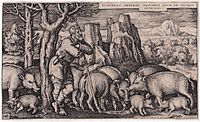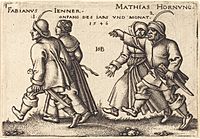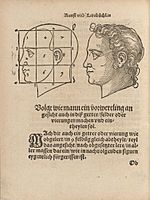Sebald Beham facts for kids
Sebald Beham (1500–1550) was a German artist famous for his amazing prints. He was born in Nuremberg and later lived in Frankfurt. He was one of the "Little Masters", a group of German artists who made very small, detailed prints after the famous artist Dürer.
His full name is often given as Hans Sebald Beham, but there is no proof he ever used "Hans."
He created about 252 engravings, 18 etchings, and 1500 woodcuts. Many of his engravings were tiny, sometimes as small as postage stamps! This is why he was part of the "Little Masters" group. He printed and sold these small works himself. His larger woodcuts were usually made for others. His engravings were popular with collectors in Germany. He also made prints for playing cards and even wallpaper.
His early art was influenced by Dürer, who was still working in Nuremberg. Beham sometimes used ideas from Dürer's work. Later, Beham bravely re-imagined some of Dürer's most famous prints, like his Melancholia from 1539. He made them his own by changing their size and style.
Contents
Life of Sebald Beham
Beham was born in Nuremberg. We don't know much about his parents. His brother, Bartel Beham, was also an artist and was two years younger. We don't know who taught Sebald. By 1521, he was a "journeyman painter," and by 1525, he had his own art workshop in Nuremberg.
In January 1525, Sebald, his brother, and another artist named Georg Pencz were asked to leave Nuremberg. They were accused of having beliefs that went against the city's rules and not respecting the city council. People sometimes called them "godless painters." The city leaders were Catholic at the time, and Beham had Lutheran beliefs. However, the city adopted Lutheranism as its official religion just two months later.
The three artists were soon allowed to return to Nuremberg. But in 1528, Beham quickly left the city again. This was because he faced legal trouble over a book he wrote about how to draw horses. People thought he had copied ideas from an unpublished book by Albrecht Dürer, who had recently passed away.
After leaving Nuremberg, Beham worked in different German cities. His woodcuts were published in Ingolstadt between 1527 and 1530. In 1530, he was in Munich, where he drew the grand arrival of Emperor Charles V. This drawing was called The Military Display, 10 June 1530. From 1532, he mostly lived in Frankfurt. He became a citizen there in 1540 and stayed until he died ten years later.
Until about 1532, his prints had the initials 'HSP'. This was how his last name, Peham, sounded in Nuremberg. After this time, when he was settled in Frankfurt, his initials changed to "HSB." Many people thought the "H" meant "Hans," but it probably came from the second part of his last name.
We know he was married twice. In 1540, there were models for medals that showed Beham and his wife, Anna. In 1549, after Anna passed away, Beham married Elizabeth Wolf. She was the daughter of a shoemaker from Büdingen.
It's important not to confuse him with another artist named Hans Beham, also from Nuremberg. That Hans Beham helped cast a famous bell called "Zygmunt" for the Wawel castle in Poland.
His Art and Prints
Beham is best known for making many prints. But he also painted, designed stained glass, and wrote two popular illustrated books that helped other artists.
Tiny Engravings and Woodcuts
Beham was a master of making very small, detailed engravings. These tiny works were often no bigger than a postage stamp. He was part of the "Little Masters" group because of the small size of his prints. He printed and sold these himself. He also made many woodcuts, which were usually larger and made for specific customers. His engravings were very popular with art collectors in Germany. He even made prints for playing cards and wallpaper.
Other Talents
Paintings and Stained Glass
Beham designed stained glass in Nuremberg. His only known painting on a wooden panel is a tabletop that shows scenes from the life of King David. This painting is now in the Louvre museum. He made it after moving to Frankfurt for a church leader named Cardinal Albrecht of Brandenburg. He also painted tiny pictures for a prayer-book for Albrecht. Some painted coats of arms, made for new noble families, can still be found in the city archives in Frankfurt.
Books for Artists
Beham wrote a book about how to draw horses. This book caused him to be exiled for a short time in 1528 because people thought he copied ideas from another artist. He later wrote another book about drawing the human body. These books were simpler versions of Dürer's works on the same topics. Because they were easier to use and cheaper, they were very popular for a long time.
Gallery
-
One of a set on the Prodigal Son, 1538
See also
 In Spanish: Hans Sebald Beham para niños
In Spanish: Hans Sebald Beham para niños
- Barthel Beham





